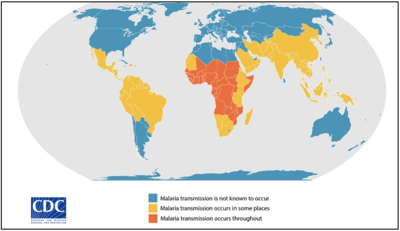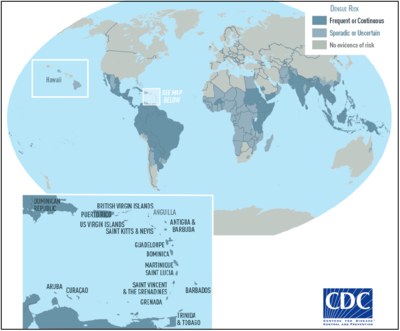Disease Focus
The Spatial Repellents Program has focused its research on two globally important diseases, dengue fever and malaria. According to the World Health Organization, 214 million cases of malaria were reported in 2015, with 50 million to 100 million dengue infections occurring every year. Both diseases are present in tropical and sub-tropical areas world-wide, and both are transmitted through the bites of infected mosquitos. There are not yet any commercially-wide vaccines for either disease, therefore prevention of mosquito-human contact, and early recognition and treatment of infection, are critical to controlling these diseases.
Malaria

Malaria is transmitted exclusively through the bites of particular anopheline mosquitoes. When the bite of the female mosquito introduces the parasites into the person’s blood, the parasites travel to the liver, mature and reproduce later escaping the liver and infecting red blood cells. The incubation period for symptoms to occur takes between 7 to 30 days and leads to a wide variety of symptoms, ranging from absent or very mild symptoms, to severe disease and even death. The intensity of transmission depends on factors related to the parasite, the vector, the human host, and the environment. In general, malaria is a curable disease if diagnosed and treated promptly and correctly.
Dengue

Dengue disease is caused by one of the four closely related dengue viruses (DENV 1, DENV 2, DENV 3, or DENV 4) and is transmitted to people by the bite of an Aedes type mosquito. The principal mosquito vector of dengue viruses is Aedes aegypti, also called the yellow fever mosquito. Aedes aegypti has lyre shaped markings and banded legs. These mosquitoes prefer to bite indoors, mostly on mammals and especially humans, and primarily bite during the daytime.
A person infected with dengue virus can either have symptoms of dengue fever or Dengue Hemorrhagic Fever (DHF), or they may have no symptoms at all. DHF is a more severe form of the dengue fever. The incubation period for first symptoms to occur is between 4-10 days: fever, headache, pain behind the eyes, appetite loss, muscle and joint pain, and rash.
People experiencing DHF can also develop liver or heart problems, bleeding under the skin, from the nose or the gums, and breathing difficulty. Generally, younger children and those with their first dengue infection have a milder illness than older children and adults. Recovery from infection by one dengue virus type provides lifelong immunity against that particular serotype. There is no specific treatment for dengue, therefore early detection and access to medical care, along with mosquito control, remain the mainstay for disease prevention.